Square root algorithm
The square root algorithm, which helps to get the square root without using a calculator, is not taught a lot in school today.
If you want to understand how to get the square root without using a calculator, study the following example carefully!
Sorry, there are no shortcuts for this square root algorithm, so you will need patience before you master this algorithm!
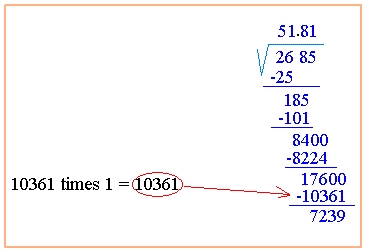
Square root algorithm to find the square root of 2685
Example: Square-root of 2685
I will use a space to show that they are being grouped in pairs. In this case, we have two pairs of 2 numbers.

Then, using the first pair, (26) find a number whose square is less than 26.
5 × 5 = 25 and 6 × 6 = 36, so your number is 5. Put 5 on top of the square root sign.

Subtract the square of the number on top that is 5 from the first pair.
Very important! : When you first start, you always take the square root of the pair or single number in the leftmost position. After that, you always double the number on top.

Bring down the next pair of numbers (85).

Then, double 5 to get 10 and put 10 next to 185 on the left side.

For the number 10, you will try to find a number you can put next to 0, which will also go next to 5.
Let's call this number z. Then, find z such that 10z × z is less or equal to 185, but never bigger than 185.
If I put 2 next to 10, I get 102 × 2 = 204 and 204 is bigger than 185, so z = 2 is not the number I need.
However, if I put 1 next to 10, I get 101 × 1 = 101 and 101 is smaller than 185.
Thus, z = 1 is the number I will put next to 10 and 5.
101 is the number I will subtract from 185.
Put the 1 on top of the square root sign next to 5

Subtract 101 from 185
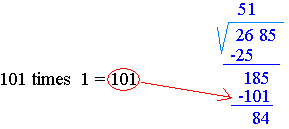
Bring down a pair of zeros next to 84 to continue the process and put a decimal point next to 51.

Double 51 to get 102 and put 102 next to 8400 on the left side.
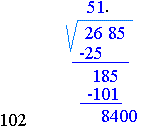
For the number 102, you will try to find a number you can put next to 2, which will also go next to the decimal point.
Let's call this number z again. Then, find z such that 102z × z is less or equal to 8400, but never bigger than 8400.
If I put 9 next to 102, I get 1029 × 9 = 9261 and 9261 is bigger than 8400.
However, if I put 8 next to 1028, I get 1028 × 8 = 8224 and 8224 is smaller than 8400. Thus, z = 8 is the number I will put next to 102 and the decimal point.
8224 is the number I will subtract from 8400.
Put 8 on top of the square root sign next to 102 and the decimal point.

Subtract 8224 from 8400
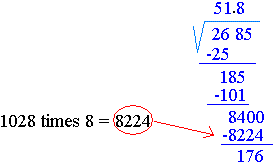
Bring down a pair of zeros next to 176. Double 518 ignoring the decimal point to get 1036 and put 1036 next to 176000.
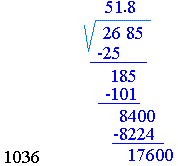
For the number 1036, you will try to find a number you can put next to 6, which will also go next to 8.
Let's call this number z again. Then, find z such that 1036z × z is less or equal to 17600, but never bigger than 17600.
If I put 2 next to 1036, I get 10362 × 2 = 20724.
Since when z = 2, I get 20724 and 20724 is bigger than 17600, z = 2 is not the number I need.
However, if I put 1 next to 1036, I get 10361 × 1 = 10361 and 10361 is less than 17600. Thus, 10361 is the number you will subtract from 17600.
1 is the number you will put next to 1036 and 8.
Put 1 on top of the square root sign next to the decimal point.
Subtract 10361 from 17600
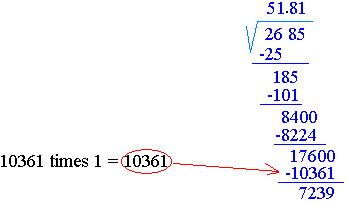
I will stop here because it is a lot of work to put this square root algorithm here for you. Appreciate my effort? Look for the donation button below and please make a donation to keep this website running.
Feel free to continue the square root algorithm to get more decimal numbers, but I think I am done.
If you were looking for the square root of 785 for instance, the square root algorithm does not change at all.
Notice that when you group the number in pairs starting from right to left, there will be only 1 number in the leftmost position. That number is 7 and that is fine.
Just start with 7 and say to yourself, " The square of what number is less than 7 and proceed an already outlined above.
I thought I said I was done. Why am I still talking about this square root algorithm?